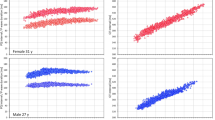Abstract
The standard 12-lead Electrocardiogram (ECG) system is the most commonly used technique for obtaining the electrocardiographic signal to evaluate the heart’s electrical activity. In the surface ECG, atrial repolarization (Ta wave) is not observed. However, during the exercise stress test, ST-segment depression validates the existence of Ta wave.To record the Ta wave and enhance atrial depolarization (P wave) in Sinus Rhythm (SR) ECG, Modified Limb Lead (MLL) system is used. PTa Interval (PTaI) represents the duration from the beginning of P wave to the end of Ta wave. This study aims to develop a corrected PTaI (PTac) formula to correct the PTaI from MLL ECGs for different heart rates. ECGs were recorded from 35 volunteers in SR and Sinus Tachycardia (ST) condition of mean age 24 ± 5 years using EDAN PC ECG system. Regression analysis was implemented on the recorded data to derive the slope for PP Interval (PPI) vs. PTaI plots in both groups. In SR group, PPI correlated well with PTaI (r = 0.48) compared to the ST group (r = 0.17). A new corrected PTaI (\({\text{PTa}}_{\text{c}} {\text{N}}\)) formula was developed from the slope values of SR and ST and compared with the previously developed PTac formula. The developed PTac formula of this study showed accurate results with the least slope in different heart rates. Implementation of new PTac formula in automatic algorithms further improves the clinical diagnosis related to atrial ECG components.
Access this chapter
Tax calculation will be finalised at checkout
Purchases are for personal use only
Similar content being viewed by others
References
K.L. Briggs, A digital approach to cardiac cycle. IEEE Eng. Med. Biol. 13, 454–456 (1994). https://doi.org/10.1109/51.310982
H.B. Sprague, P.D. White, Clinical observations on the T wave of the auricle appearing in the human electrocardiogram. J. Clin. Invest. 1, 389–402 (1925). https://doi.org/10.1172/jci100020
D.I. Abramson, N.M. Fenichel, C. Shookhoff, A study of electrical activity in the auricles. Am. Heart J. 15, 471–481 (1938). https://doi.org/10.1016/s0002-8703(38)90301-1
T. Joao, A. Victor, O. De Martin, Atrial repolarization-its importance in clinical electrocardiography. Circulation 22, 635–644 (1960). https://doi.org/10.1161/01.cir.22.4.635
H. Hayashi, M. Okajima, K. Yamada, Atrial T (Ta) wave and atrial gradient in patients with A-V block. Am. Heart J. 91, 689–698 (1976). https://doi.org/10.1016/s0002-8703(76)80533-9
P. Langley, A. Murray, Analysis of the atrial repolarisation phase of the ECG in health and in atrial fibrillation. Comput. Cardiol. 34, 785–788 (2007). https://doi.org/10.1109/cic.2007.4745603
Z. Ihara, A. van Oosterom, R. Hoekema, Atrial repolarization as observable during the PQ interval. J. Electrocardiol. 39, 290–297 (2006). https://doi.org/10.1016/j.jelectrocard.2005.12.001
Y. Wang, Y. Rudy, Electrocardiographic imaging (ECGI) of normal human atrial repolarization. Heart Rhythm. 6, 582–583 (2009). https://doi.org/10.1016/j.hrthm.2008.07.024
S. Jayaraman, V. Sangareddi, R. Periyasamy, J. Joseph, R.M. Shanmugam, Modified limb lead ECG system effects on electrocardiographic wave amplitudes and frontal plane axis in sinus rhythm subjects. Anatol. J. Cardiol. 17, 46–54. https://doi.org/10.14744/anatoljcardiol.2016.6843 (2017)
J. Sivaraman, G. Uma, M. Umapathy, A modified chest leads for minimization of ventricular activity in electrocardiograms, in IEEE International Conference on Biomedical Engineering, pp. 79–82. https://doi.org/10.1109/icobe.2012.6178959 (2012)
J. Sivaraman, G. Uma, S. Venkatesan, M. Umapathy, M.S. Ravi, Unmasking of atrial repolarization waves using asimple modified limb lead system. Anatol. J. Cardiol. 15, 605–610 (2015). https://doi.org/10.5152/akd.2014.5695
J. Sivaraman, G. Uma, S. Venkatesan, M. Umapathy, V.E. Dhandapani, Normal limits of ECG measurements related to atrial activity using a modified limb lead system. Anatol. J. Cardiol. 15, 2–6 (2015). https://doi.org/10.5152/akd.2014.5155
J. Sivaraman, G. Uma, S. Venkatesan, M. Umapathy, N. Keshav kumar, A study on atrial Ta wave morphology inhealthy group: An approach using P wave signal-averaging method. J. Med. Imaging Health Inform. 4, 675–680 (2014). https://doi.org/10.1166/jmihi.2014.1306
J. Sivaraman, R. John, Effects of sinus rhythm on atrial ECG components using modified limb lead system, in 4th International Conference on Signal Processing Computing and Control, pp. 527–530. https://doi.org/10.1109/ispcc.2017.8269735 (2017)
J. Sivaraman, G. Uma, P. Langley, M. Umapathy, A study on stability analysis of atrial repolarization variability using ARX model in sinus rhythm and atrial tachycardia ECGs. Comput. Methods Programs Biomed. 137, 341–351 (2016). https://doi.org/10.1016/j.cmpb.2016.10.005
A. Jyothsana, B. Arya, J. Sivaraman, Stability analysis on the effects of heart rate variability and premature activation of atrial ECG dynamics using ARMAX model. Phys. Eng. Sci. Med. 43, 1361–1370 (2020). https://doi.org/10.1007/s13246-020-00940-w
A. Schneider, G. Hommel, M. Blettner, Linear regression analysis. Dtsch Arztebl Int. 107, 776–782 (2010). https://doi.org/10.3238/arztebl.2010.0776
N.M.G. Debbas, S.H.D. Jackson, D. De Jonghe, A. Robert, A.J. Camm, Human atrial repolarization: Effects ofsinus rate, pacing and drugs on the surface electrocardiogram. J. Am. Coll. Cardiol. 33, 358–365 (1999). https://doi.org/10.1016/s0735-1097(98)00580-4
Acknowledgements
The authors acknowledge the support from the Ministry of Education, Government of India. The present study was supported by financial grants from the Science and Engineering Research Board (SERB), Department of Science and Technology (DST), Government of India (EEQ/2019/000148).
Author information
Authors and Affiliations
Corresponding author
Editor information
Editors and Affiliations
Rights and permissions
Copyright information
© 2022 The Author(s), under exclusive license to Springer Nature Singapore Pte Ltd.
About this paper
Cite this paper
Karimulla, S., Bhardwaj, A., Sivaraman, J., Dhananjay, B. (2022). Development of Optimal Corrected PTa Interval Formula for Different Heart Rates. In: Thakkar, F., Saha, G., Shahnaz, C., Hu, YC. (eds) Proceedings of the International e-Conference on Intelligent Systems and Signal Processing. Advances in Intelligent Systems and Computing, vol 1370. Springer, Singapore. https://doi.org/10.1007/978-981-16-2123-9_20
Download citation
DOI: https://doi.org/10.1007/978-981-16-2123-9_20
Published:
Publisher Name: Springer, Singapore
Print ISBN: 978-981-16-2122-2
Online ISBN: 978-981-16-2123-9
eBook Packages: Intelligent Technologies and RoboticsIntelligent Technologies and Robotics (R0)




